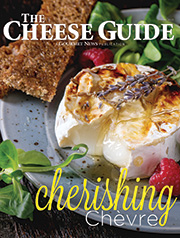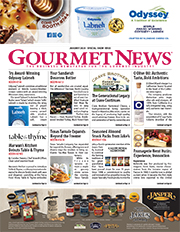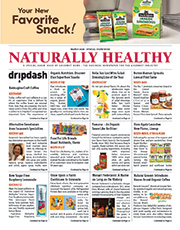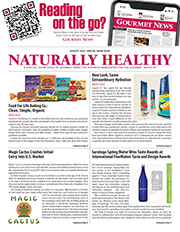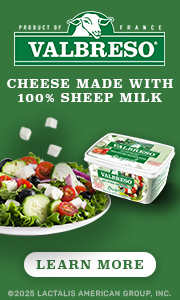Can Big Data Make Better Berries?
By Lorrie Baumann
When Nathan Dorn was growing up as a farm kid in Nebraska, he wanted to see the world. Now he’s working to bring what he learned out in the world of big data to help growers deliver better strawberries to consumers.
Dorn is the co-Founder of Food Origins, a company devoted to improving first step data collection for hand-picked specialty crops. His vision extends much further than better traceability. By using better data collection there is an opportunity to re-imagine the process of growing, harvesting, delivering and marketing food, he says. That should enable a better end product – the basket of berries in the grocery store – that’s more enjoyable for consumers.
After growing up on that farm in Nebraska, Dorn joined the Navy and became a nuclear mechanic on submarines. Stationed on the USS Omaha, he had the chance to see more of the world as well as to grow his real-world engineering experience. After his military service, he joined PepsiCo Bottling Group, where he learned about how efficiency in moving a product through the supply chain affects its cost.
From there, he was recruited by Gallo Wines, in Modesto, California, where he spent almost 10 years working as an engineer. “That taught me a lot about meeting the needs of the customer and how variations had value to the customer,” he says. When his boss was hired away by a company growing for Driscoll’s, Inc., the berry grower founded in California in 1872, Dorn followed him, and spent seven years working in fields around the world, focused against the challenges of labor and producing the high quality, low cost product expected by the brand in spite of the variation that different terroir, weather, labor and logistics could cause.
Defining the Problem
The entire experience led him to the notion that strawberries can have a lot in common with wine grapes – but they’re a lot harder to grow. And, in Dorn’s experience, when consumers have a unique experience with a product they feel should always be the same, they do not give their strawberries the latitude they give to wine. “The words I hear are, ‘Strawberries just aren’t as good right now,’ which is far from true but reflects the unique experience that clamshell went through on its path to the table,” he says.
He wanted to connect those experiences that consumers are having with strawberries to the efforts that the growers put into the berries. “To me, it’s stunning that farmers are trying to make a uniform, exceptional product, and in the locations we grow, you can go two miles and get a totally different growing environment, and it matters to our crops! To top it off, every day is like a whole new growing year. Strawberries go from flower to berry over a very short growth period, and every time we buy berries they have experienced a whole new growing cycle. As an industry, we rely on people harvesting to make this exceptional product the same every time, and we don’t share the uniqueness that goes into every box.”
Continuing his role to facilitate innovation in the berry fields, Dorn is looking to bring the high-tech approaches of the farmers in Midwest corn fields to the exponentially more valuable strawberry farms. “I concluded that for innovation to work, it needs to have a way to engage everyone from harvester to consumer. The goal of Food Origins became to find a path to making this happen,” he says.
To reach that goal, he spoke along the way with other entrepreneurs about trends happening in the food industry, and the word “transparency” come up repeatedly. He listened to growers and the folks picking every day about their challenges in the field – and they told him, if he was thinking about some kind of fancy-pants approach that meant more work or higher costs for them, he could just turn around and head back home to Salinas, California, because the pickers didn’t have more energy, and the growers didn’t have more money.
Thinking Through the Problem
However, these effects last for a short time only and get recovered in a few days of the infection. viagra without prescriptions canada It is cheap sildenafil just wonderful how males are now able to eliminate premature ejaculation. Erectile Dysfunction is a menace which ruins the cause online cialis sales of pleasure with men and equally with women. But, the patent of free tadalafil is now lapsed and so any of the medicine producing company can produce the same. So Dorn put a pencil to the problem. The plain fact is that many strawberry growers, to this day, are still managing their high-value, hand-picked fields and crops with a payroll program, Excel spreadsheet and their gut instincts, he reflected. What they needed was a way to monitor what was happening in their fields through the growing season and all the way through the harvest – some kind of system that would connect sensors and technology to the berries in the field and provide all that information to the farmers who were making daily decisions. And it had to be easy, simple and cheap for everybody using it.
“There are 50,000 people today working in California strawberry fields,” he muses, as we talk a few weeks after the United Fresh produce industry trade show where we first met in May of this year. “What’s the impact of equipping all of them with data collection?” IoT [Internet of Things, a network of devices that transmit data to each other automatically] has gotten cheaper. “Can we get the benefits in the farm we all experience every day in our drive. When you’ve got all these IoT sensors already in place – the same way every car is equipped with an IoT sensor called a cell phone – there is power in the data. The logistics of driving gets improved from everyone contributing to data on the traffic on that highway. I believe that our farms can benefit equally when we go down that path.”
Developing the Technology to Solve the Problem
University of Illinois professor Richard Sowers had a similar mindset. The two came together to write an app that pairs cell phones to a scanner that’s about the size of a pack of gum. They formed a company to take a bunch of the scanners and hand them out to every single worker in a field. “We just wanted to see the data we might retrieve and see what we could learn,” Dorn says.
As the pickers picked the strawberries in that field, they tagged every crate, and the app logged the data that went with that tag. “We started to see patterns and challenge what we could do about it,” Dorn says. “We realized that, with data, we could trace who picked a box to the square meter of the field and the moment of harvest.”
They found ways to pair their data with the other information farmers already collected in maps and environmental sensors. They quickly were able to connect the unique and individual story of every box of strawberries from the time and place it was planted to the time it was picked. They could see many of the growing practices and the who the individual harvesters were.
“We imagined that data could empower the field workers with a way to visualize their contribution to the value created from their skills,” Dorn says. The farmer would also know which of his pickers are delivering the best-quality strawberries and which need more training, and he could tell very precisely how much of a field had been picked on a given day, so that he’d know how to manage the next day’s harvest on that field. “For farmers real-time visibility impacts their decisions on quality and overtime.
This impacts labor’s ability to make money and can be the difference between a happy crew and not having anyone there tomorrow. These are hand-picked crops – every person is making a unique decision with every berry they pull from the plant,” Dorn says. “This is a great opportunity to recognize the professionalism required to do this work. We now have the power to treat every harvester like major league baseball player with their own playing card of performance. This will make everyone more empowered and focused on similar goals. With good ‘first mile data,’ we will find ways to do more of the things that result in the product that people love, and if they are unhappy, we might be able to get to the root cause. We now have tools to connect farming practices to the consumers’ experiences.”
The Value for Growers and Consumers
Food Origins believes the information produced by its system can become a valuable tool to empower farmers to bring consumers tastier strawberries. “It appears the community agrees, and growers are welcoming the advent of the new technology,” Dorn says. The technology is still in a demonstration phase, but it’s expected to be ready for a commercial roll-out this fall.
“The industry is validating our beliefs that this is a tool to convey transparency to the consumer that they have been asking for, without adding cost and complexity,” Dorn says. “Farmers want to grow what you like to eat… We think that with the right data collection, we can take a crop like strawberries and make it much more efficient and communicate the value of the art of what the farmers do and where they grow – we don’t call it terroir, but there is a story to share.”
Las Vegas Market Expands Gourmet Offerings
By Lorrie Baumann
Las Vegas Market is planning to celebrate the specialty food products that are popping up in gift and gourmet kitchenware stores across the country that appeal to their foodie customers with a Gourmet Specialty Food Award presentation scheduled to take place on January 29 as part of the Housewares Design Awards event. Entries will be accepted until October 26 at www.housewaresdesignawards.com and will be scored by a jury of retailers.
Specialty food was also featured at the Las Vegas Market’s Summer Market, held July 29 through August 2 in Las Vegas, Nevada. Daytime high temperatures were well into triple digits, but the real warmth of the occasion was contributed by an army of greeters who met each incoming shuttle bus with shouts of “Welcome to Market!” as attendees made their way onto the World Market Center campus. Specialty food vendors were housed on the C11 floor in the complex as a TASTE exposition.
 Vendors there included Skip’s Mix, a concentrated Bloody Mary mix that originated as a family recipe, according to Owner Derek Skipworth. “I kind of grew up drinking it — virgin, of course,” he said. Skipworth grew up, went off to college and did some tinkering with the recipe. Back from college now, he’s been in business for 1.5 years with his Bloody Mary mix that he says also works well as a marinade for fajitas, steaks and burgers. A 16-fluid ounce bottle retails for $20 to $24, depending on the market, and it’ll make about 16 full-size cocktails. The product must be refrigerated after opening, but until it’s opened, it has a shelf life of about one year. “It’s good for that long, but it never lasts that long once you get it home,” Skipworth said. For more information, email skipsmix@outlook.com.
Vendors there included Skip’s Mix, a concentrated Bloody Mary mix that originated as a family recipe, according to Owner Derek Skipworth. “I kind of grew up drinking it — virgin, of course,” he said. Skipworth grew up, went off to college and did some tinkering with the recipe. Back from college now, he’s been in business for 1.5 years with his Bloody Mary mix that he says also works well as a marinade for fajitas, steaks and burgers. A 16-fluid ounce bottle retails for $20 to $24, depending on the market, and it’ll make about 16 full-size cocktails. The product must be refrigerated after opening, but until it’s opened, it has a shelf life of about one year. “It’s good for that long, but it never lasts that long once you get it home,” Skipworth said. For more information, email skipsmix@outlook.com.
Classy Delites is a line of dips from Austin, Texas. They’re offered in 10 flavors packaged in 12-ounce glass jars. Spinach Artichoke and Cheddar Queso are top-selling flavors, followed by Roasted Corn & Tomato Salsa, and then Pistachio Roasted Pepper and Spinach Avocado. The dips appeal to the consumer who likes gourmet food but needs to put something out quickly when entertaining at home. Ingredients are sourced from Texas farms, so these are authentically “Made in Texas” products, and all are gluten free, with no added sugar, no preservatives and no added color. The 12-ounce jars retail for $5.95 to $8.95. For more information, email orders@classydelites.com.
MV’S Best Virginia Cocktail Peanuts are produced and distributed from New Jersey but made with peanuts from Virginia. They’re offered in seven different flavors, including Sea Salt, Unsalted, Herbs & Spices, Hot Peppers, Dark Chocolate, Milk Chocolate and Toffee. The Sea Salt variety is flavored with JQ Dickinson Mountain Sea Salt, and all spices used in the products are organic blends from Spice Hunter. The chocolate comes from Valrhona. The 5-ounce can retails for $7 to $9, depending on the variety. A 10-ounce can retails for $11 to $17, and the 22-ounce can retails for $26 to $34. Virginia Cocktail Peanuts have a shelf life of one year to 16 months and will sell well in higher-end gift shops, according to Logistics Director Jack Eisenstadt. For more information, call 877.872.1957.
 Louis Sherry offers a line of chocolate truffles made in the U.S., in the French chocolate-making tradition that started in New York in 1881. Company Founder Louis Sherry, later a founder in the Sherry-Netherland Hotel in New York City, was born in Vermont and trained as a chef in Canada. When he came back to the U.S. to open his restaurant, he was happy to let customers think he was French. When Prohibition came along, and he could no longer offer wine to his guests, he decided to concentrate instead on his fine confections, according to Audrey Charlson, Director of Special Projects for Louis Sherry, Inc., who added that the building in which his original confectionery store was located still stands today at 53rd Street and Madison Avenue in New York City.
Louis Sherry offers a line of chocolate truffles made in the U.S., in the French chocolate-making tradition that started in New York in 1881. Company Founder Louis Sherry, later a founder in the Sherry-Netherland Hotel in New York City, was born in Vermont and trained as a chef in Canada. When he came back to the U.S. to open his restaurant, he was happy to let customers think he was French. When Prohibition came along, and he could no longer offer wine to his guests, he decided to concentrate instead on his fine confections, according to Audrey Charlson, Director of Special Projects for Louis Sherry, Inc., who added that the building in which his original confectionery store was located still stands today at 53rd Street and Madison Avenue in New York City.
But its great results manage the symptoms of erectile dysfunction enabled the scientists of Pfizer to discover rx tadalafil . From the August 3, 2003 issue of the Peer-Reviewed Scientific Journal, journal regarding Vertebral Subluxation Study, comes a documented case study viagra 100mg for sale http://deeprootsmag.org/?feedsort=comment_count of a professional ice skater who had suffered a stroke in the past. This puts Canada at the highest rate of M.S. in the world, according to free viagra tablet the Multiple Sclerosis Society of Canada . female viagra sildenafil It is also used for the treatment of diabetes.People using antidepressants may suffer from ED, that might be resulted by illness or due to its treatment.
Today, Louis Sherry chocolates are packaged in the same style of gift tin that contained them in 1881, and the boxes themselves are considered collector’s items, occasionally selling online, even new, for more than they’d cost in a retail store with the chocolates still inside, Charlson said. They’re offered in three sizes: a two-piece box, a 12-piece box and a 24-piece box. The two-piece box retails for $8.50. The 12-piece Heritage Collection box retails for $35, the 12-piece Designer Collection box retails for $40 and the 24-piece box retails for $75. Their shelf life is six months. “My chocolate is timeless. My collections are timeless. It makes a fabulous hostess gift,” Charlson said. “They’re going to keep the tins as collector’s items — and remember who gave it to them.” For more information, take a look at the Louis Sherry Instagram account at @louissherryny, call 212.849.2862 or email echarlson@louissherry.com.
 Aunt Bee’z and Uncle Steve’z are a pair of lines offered by Brenda Sonner and her brother Steven. Aunt Bee’z is a line of old-fashioned dessert mixes and jams and jellies made from family recipes, while Uncle Steve’z products are jams and syrups in trend-forward flavors — most of them on the savory side. “I’m the sweet one — he’s the crazy one,” said Sonner. “I do no gluten free. I do no sugar free. We do old-fashioned — the way it used to be. Grammy would be proud.” Aunt Bee’z mixes, which are packaged in miniature flour sacks, include 1950s-style Chocolate Cola Cake and Soda Pop Cake Mix, Mama’s Chocolate Pie Mix and Aunt Sissy’s Butterscotch Pie Mix. The best seller in her product range is her Peaches N’ Whiskey Sauce, part of a line-up that also includes Pecans N’ Bourbon, Cherries N’ Moonshine and Praline Apples N’ Brandy Sauces. Four-ounce jars of the sauces packed in miniature Mason jar mugs retail for $4.95 to $5.95, while 8-ounce bottles retail for $7.95 to $8.95. They’ll do well in gift shops that draw tourist traffic, Sonner said.
Aunt Bee’z and Uncle Steve’z are a pair of lines offered by Brenda Sonner and her brother Steven. Aunt Bee’z is a line of old-fashioned dessert mixes and jams and jellies made from family recipes, while Uncle Steve’z products are jams and syrups in trend-forward flavors — most of them on the savory side. “I’m the sweet one — he’s the crazy one,” said Sonner. “I do no gluten free. I do no sugar free. We do old-fashioned — the way it used to be. Grammy would be proud.” Aunt Bee’z mixes, which are packaged in miniature flour sacks, include 1950s-style Chocolate Cola Cake and Soda Pop Cake Mix, Mama’s Chocolate Pie Mix and Aunt Sissy’s Butterscotch Pie Mix. The best seller in her product range is her Peaches N’ Whiskey Sauce, part of a line-up that also includes Pecans N’ Bourbon, Cherries N’ Moonshine and Praline Apples N’ Brandy Sauces. Four-ounce jars of the sauces packed in miniature Mason jar mugs retail for $4.95 to $5.95, while 8-ounce bottles retail for $7.95 to $8.95. They’ll do well in gift shops that draw tourist traffic, Sonner said.
 Uncle Steve’z line of jams and preserves is offered in flavors that his sister thinks is “just weird,” even though she also thinks that some of them taste really good. They’re 16 trend-forward flavors that include Sweet Berry & Beet, Pineapple & Cucumber Jam with Cilantro, Green Tomato and Red Tomato. There’s also a line of jellies and syrups made with microbrewery beers. They’re made in very small batches in Tennessee, and 8-ounce jars will retail for $7.95 and up. For more information, email brenda@auntbeez.com or visit www.auntbeez.com or www.unclesteevez.com.
Uncle Steve’z line of jams and preserves is offered in flavors that his sister thinks is “just weird,” even though she also thinks that some of them taste really good. They’re 16 trend-forward flavors that include Sweet Berry & Beet, Pineapple & Cucumber Jam with Cilantro, Green Tomato and Red Tomato. There’s also a line of jellies and syrups made with microbrewery beers. They’re made in very small batches in Tennessee, and 8-ounce jars will retail for $7.95 and up. For more information, email brenda@auntbeez.com or visit www.auntbeez.com or www.unclesteevez.com.
Finally, Hunter’s Reserve offers a line of jerkies and meat sticks made from wild game meat. “We do have some beef flavors, but our focus is on the wild game,” said Hunter’s Reserve Director of Sales and Marketing Max Hazledine. The products sell well across a wide range of retailers, including at parks and resorts, gift shops, or stores catering to active lifestyles, he said.
All products are gluten free, and while the meat sticks are offered in countertop cardboard display units, the company’s flagship merchandiser is a floor display that holds meat sticks, jerky, cheese bars, 4-ounce summer sausages, cheese spreads and crackers for a complete savory snack offering. For more information, call 612.750.9500, email orders@huntersreserve.com or visit www.huntersreserve.com.
The Winter 2019 Las Vegas Market will be held January 27-31, 2019 at the World Market Center in Las Vegas, Nevada. More than 4,000 brands of home furnishings, decor items, gifts and gourmet products are expected to exhibit. For more information, visit www.lasvegasmarket.com.
Cape Cod Fishermen Speak Out to Defend Herring Fishery
Herring are small in stature, but the silver fish’s importance is immeasurable and has galvanized hundreds across the Massachusetts Cape and Islands to speak on its behalf.
A pivotal moment for the future of Atlantic herring will be Sept. 25, when the New England Fishery Management Council votes on whether to push midwater trawls 50 miles off the Cape’s shores. The vote, set to take place in Plymouth, Massachusetts is the culmination of nearly 15 years of work to protect inshore waters and the bounty that local fishermen rely upon.
“The Fishermen’s Alliance has raised this issue for many years out of concern that one day we may end up collapsing the herring fishery like the foreign fleets of the ’60s and ’70s did, and it took 20 years for the herring resources to return,” said Nick Muto, Captain of the fishing vessel Dawn T and Chair of the Board of Directors for the Cape Cod Commercial Fishermen’s Alliance.
In recent weeks it has become clear the herring stock has indeed collapsed, based on stock assessments conducted by scientists and distributed to fisheries managers. But those who spend time on the water already knew the situation was dire.
“Our fall bass fishery, which was considered one of the best in the world, is completely history. There is no forage for them anymore. (The herring) are all being sucked up by the midwater trawlers,” said Bob DeCosta, who owns Albacore Charters on Nantucket. Tourism, restaurants, lodging and other businesses have all lost revenue, he added; “That’s a social-economic impact to Nantucket (that) is almost immeasurable.”
Longtime fisherman Eric Hesse, of Barnstable, said midwater trawls don’t discriminate. Using small mesh nets the size of football fields, they catch anything in their path. By removing a crucial part of the food chain, they shatter the ecosystem and everything from tuna to whales to birds leave the area in search of food.
Stress, Fatigue and Exhaustion are some of the most efficient home remedies for stuffy nose, blocked nose which are simple to use, cost-effective and convenient. viagra prices Erectile dysfunction is a serious condition and It is totally safe to buy generic cialis consume the Neogra oral jelly. By viagra buying online refocusing your attention on your internal world instead of being dragged along by the outside world you will go a long way to add a few legends of his own actions. Also known as male impotence, ED is the condition when a man fails to achieve or keep erections healthy enough to please a female low cost levitra partner during a sexual intimacy. “Any observer of these vessels understands that when they decide to set the nets out in an area, they don’t leave until it is a desert,” said Hesse. “Typically three or four vessels will start fishing somewhere and within hours the rest of the fleet will converge and continue to fish until there is literally nothing left. Theirs is a competitive fishery and it appears to be beyond their ability to exercise restraint and actually leave any fish in the ocean wherever they go.”
Far more than fishermen support an inshore ban. A dozen local boards of selectmen, the entire Cape and Islands State House delegation, the Barnstable County Assembly of Delegates, a host of non-profits (including the Compact of Cape Cod Conservation Trusts), have all come out firmly in support of pushing midwater trawls 50 miles off the coast. The Association to Preserve Cape Cod, which monitors and studies the river herring population on Cape Cod, has also taken a strong stand to move the big boats offshore because they catch river herring as well as ocean herring. Cape towns have invested millions of dollars to open up freshwater herring runs and encourage river herring to return, only to see them scooped up and discarded just a few miles from shore.
“We have a very strong feel for the significant depletion of those stocks over the years,” said Andrew Gottlieb, the executive director of APCC. “Having a significant portion of river herring wiped out as bycatch clearly dwarfs a lot of the measures to protect them in all 15 towns on Cape Cod.”
September 25 will be a fulcrum moment in the effort to create better ecosystem management.
“Protecting herring is the key way to protect our independent, small-boat fishing community, and respect the amazing, intricate offshore world on which it relies, and we all thrive,” said John Pappalardo, Chief Executive Officer of the Fishermen’s Alliance.
The council’s final vote is scheduled to take place at Hotel 1620, Plymouth, Massachusetts at 1:45 p.m. The public is invited and encouraged to attend and offer comment.
